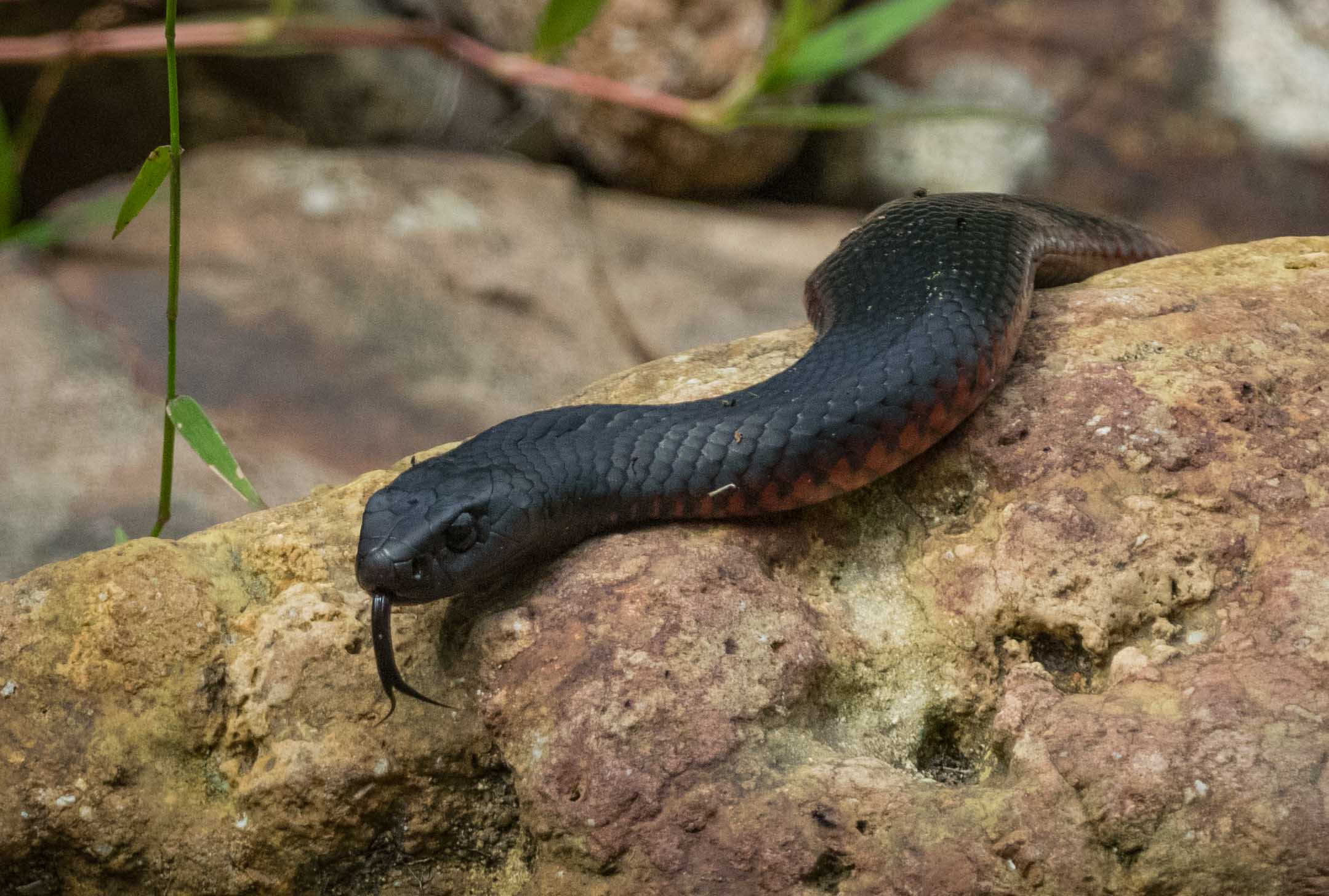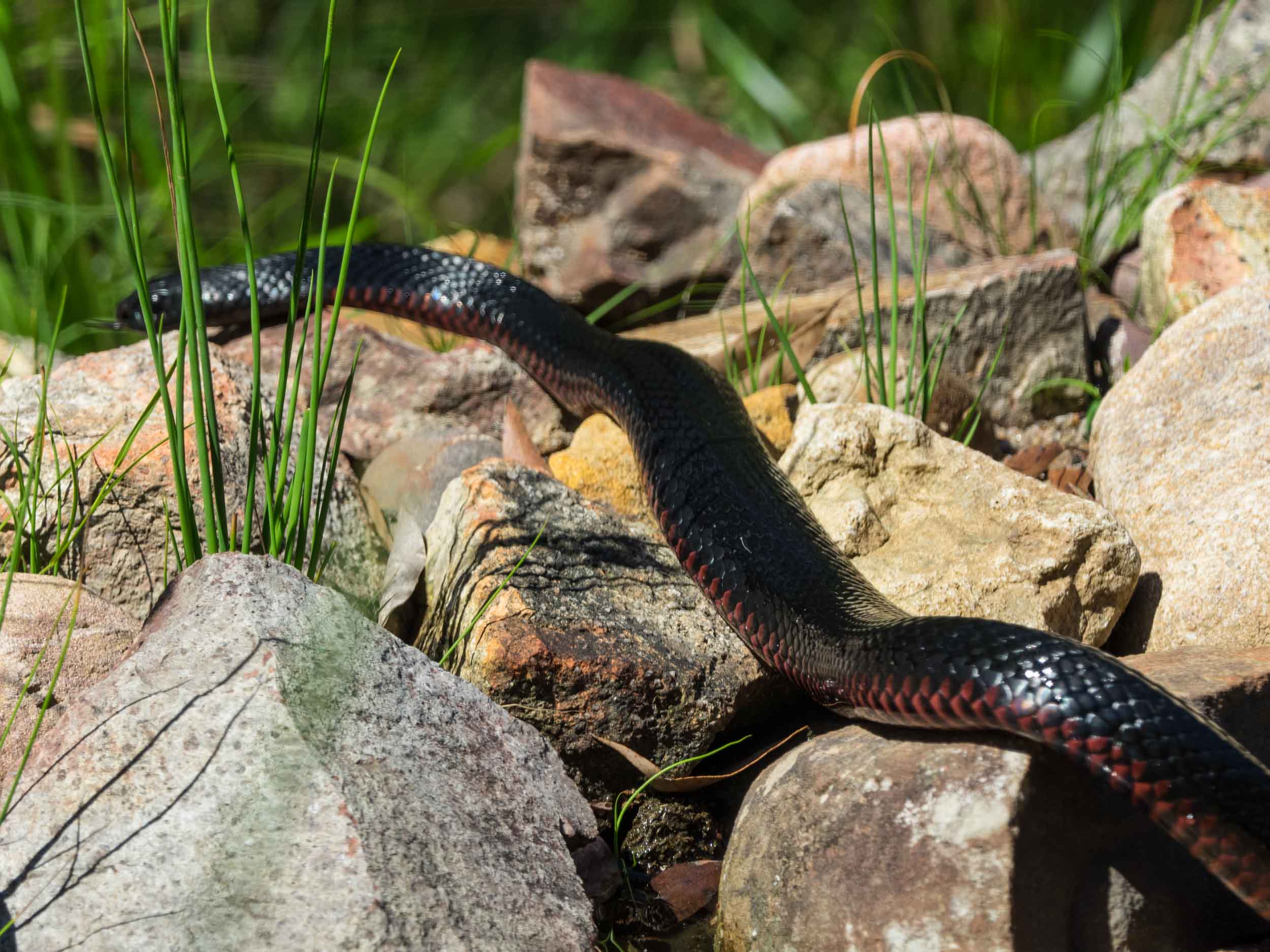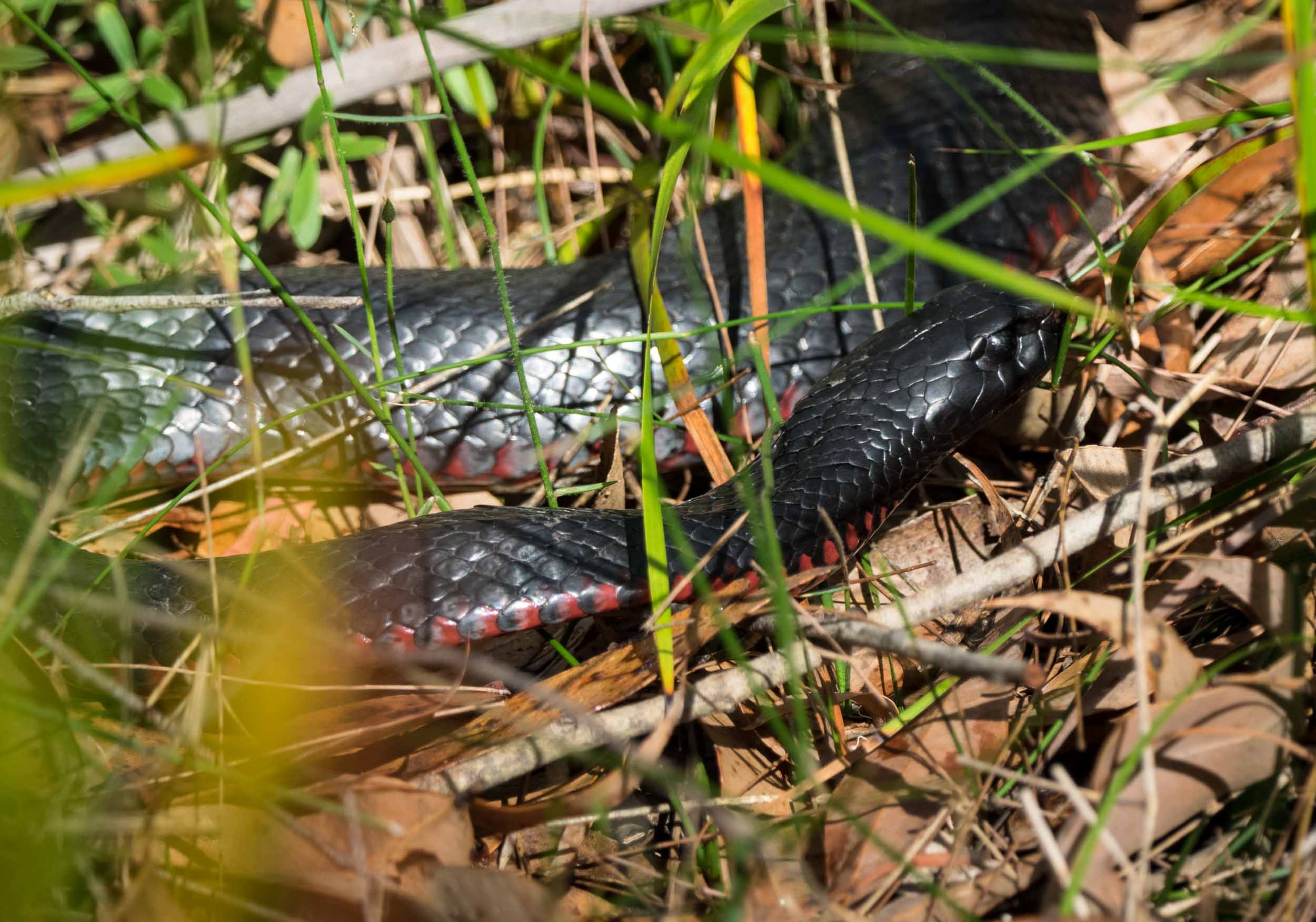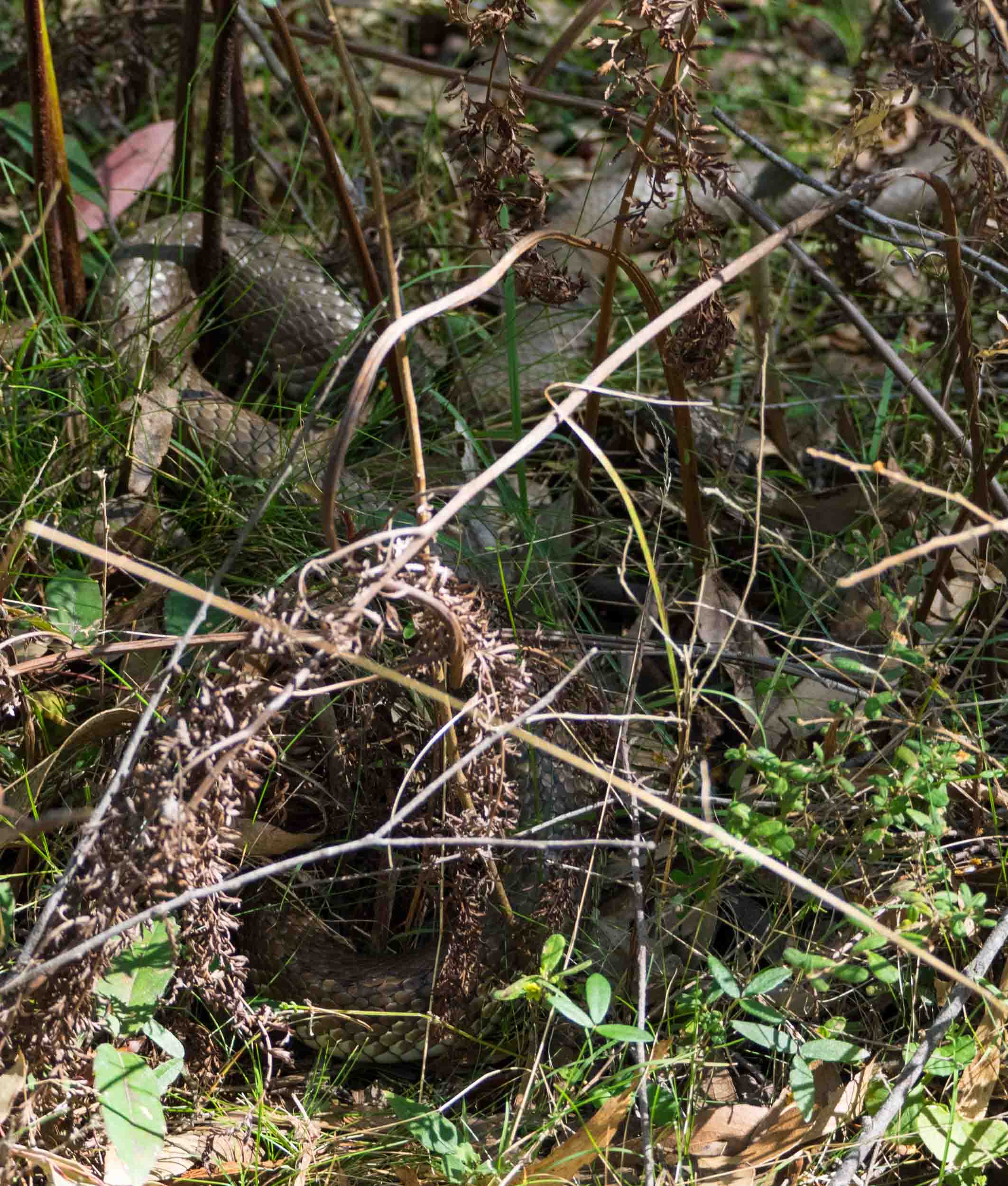Snake season
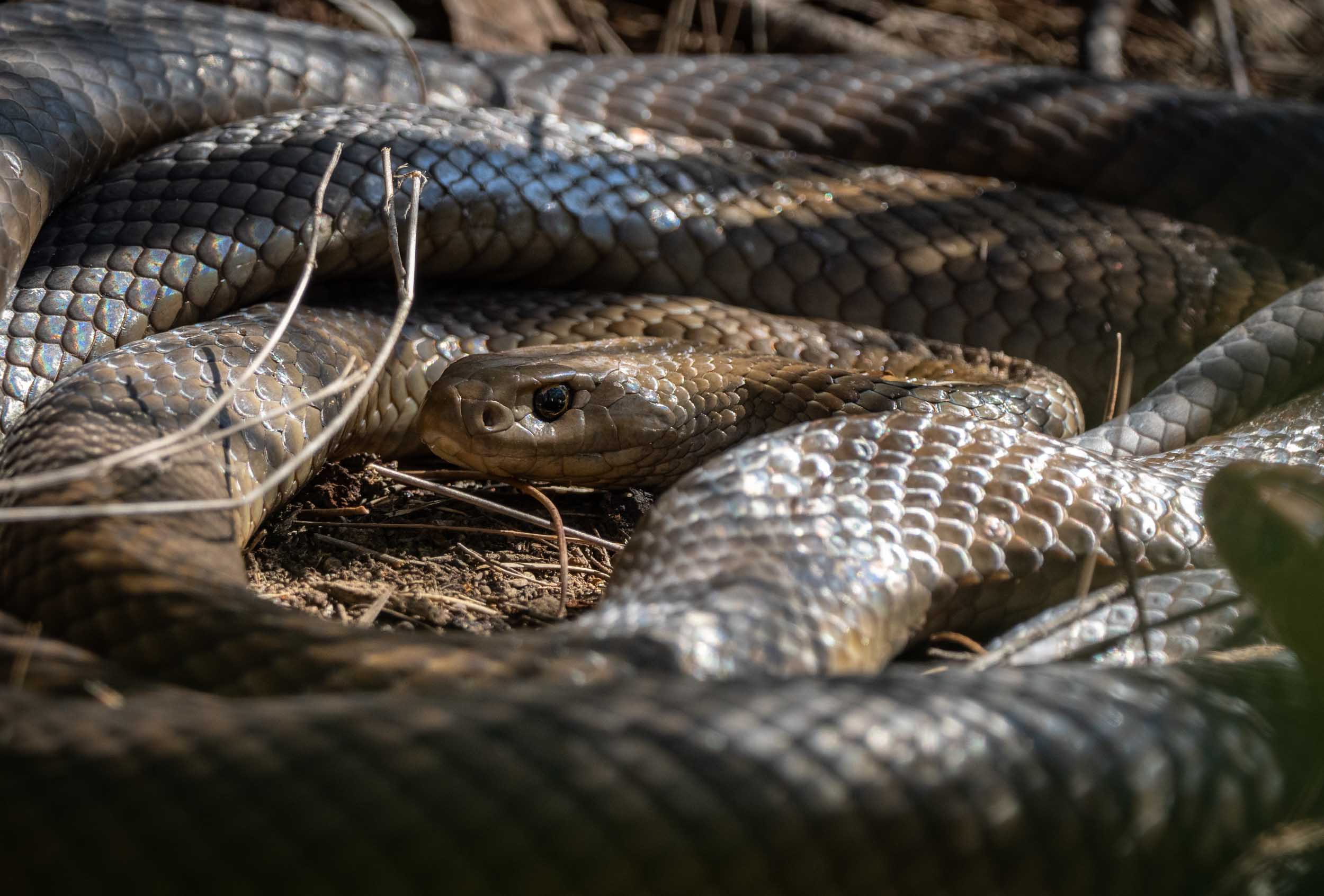
Yesterday was the first truly hot day this Spring. A glorious day with no wind and a top of 33 degrees on parts of the block. A good day for snakes and snake-spotting, I figured – but I could never have guessed just how good.
On a west-facing rocky cliff is what we call the ‘snake spot’. Over the years we’ve watched an array of different snake species take up residence under the same small pile of rocks. Almost certainly not at the same time, of course. Immediately behind the rock pile is their favoured sun baking spot. It’s a spot I check regularly and where, over the years, I’ve made some rather nice sightings.
However, yesterday’s sighting is the best yet! A pair of Eastern Brown Snakes in a mating tangle. My first thought when I saw them … ‘that’s a lot of snake flesh … there must be more than one!’
Two heads, two tails … two rather sizeable snakes
Yes, two heads and two tails. Not moving. One snake (on the right in the photo above) was alert and clearly watching me. Let’s call her ‘she’ for now.
I crept along the path a little, for a clearer view. Not closer, just past some of the small bushes obscuring my view.
She didn’t like that and slowly started to uncoil. … giving me a much better look at the second snake. ‘He’ had been tightly coiled within the more posterior loops of her body.
I was feeling rather pleased. A good shot of the head is valuable for species identification … more about that later.
It was the next glimpse that was truly remarkable. As she headed for her nearby burrow in the rock pile, the end of her body – and his – came into view. Snake coupling is something I’ve never seen before! Apparently it’s something rarely ever seen in the wild.
Now to be honest, I can’t tell which is the male and which the female. I’ve read that males have a longer, thicker tail but this Escher puzzle of loops and scales has me a little confused. The pinkish structure is clearly the penis, but which snake it belongs to I’m not at all sure.
The first snake (‘she’) disappeared under the rocks, dragging the second one behind as they remained locked tail to tail. ‘He’ gave me what I interpret as a rather grumpy (but not overtly threatening) look, and then allowed himself to be pulled backwards into her retreat.
It all happened quite quickly. But those two minutes have sparked several hours of research and reading as I try to understand more about the spectacle I so briefly witnessed. Here’s some of what I have learned.
Species check
I’m confident that these are Eastern Brown Snakes, Pseudonaja textilis.
In our area it is surprisingly easy to confuse Tiger Snakes (Nototechis scutatus) and Eastern Brown Snakes as the local Tiger Snakes often lack stripes. The most accurate test is a close look at the scales under the tail, but that’s tricky. Even these photos, where the tail is quite visible, don’t show the detail needed.
For the next-best features you simply need a good face shot. I’m basing my identification on the pale iris and the narrow head. Tiger Snakes have a very wide head, their eyes fully dark and perhaps a little smaller.
Mating behaviour
Snakes don’t form lasting pair bonds. Males live solitary lives. Female Brown Snakes will share their burrows with other females but not with adult males (#2).
I’m guessing that the cliff-top rock pile burrow currently belongs to the female. Males emerge early in Spring and then seek out females that typically first emerge in late September (#2). Males wander further, so it seems likely that he was visiting her – not the other way around. Of course, I can’t be sure of this. What researchers have shown is that Eastern Brown Snakes have a core home territory within which they overwinter and where a female will lay her eggs (#2). But during Summer they move about a larger range of 5 hectares or so, staying for a week here and a week there. They are almost entirely day-active, always spending the night in a burrow or crack in the earth.
I have no idea how long the pair had been bonded before I disturbed them. Captive Eastern Brown Snakes have been seen to couple for 4 hours, so no great surprise that my interruption didn’t really disrupt proceedings. They probably just continued underground.
A penis with hooks
OK, it might seem a bit perverse, but I just had to read more about the snake penis. It is clearly an impressive organ.
Snakes and lizards actually have two penises (each is called hemipenis, but that’s just terminology) (#3). A sexual encounter only ever involves one. The other is kept ready and loaded for next time, thus avoiding the ‘refractory period’ experienced by mammals (#3). If your chances of finding a mate are infrequent, I guess you need to be able to make the most of the limited opportunities available.
Believe it or not, the ‘hemipenial morphology’ of the Eastern Brown Snake has been studied. Pseudonaja are unique in their large, basal spines. There is an array of other features useful in deciding how closely different species of snakes are related. If you find all this fascinating, read more in this 1999 paper by J.S. Keogh.
Diagram from J. Scott Keogh. 1999. Evolutionary implications of hemipenial morphology in the terrestrial Australian elapid snakes. Zoological Journal of the Linnean Society (1999), 125: 239–278. (from Figure 2B: Hemipene of Pseudonaja affiris scale bar 3mm)
What happens next
After mating, the female will probably stay quite close to home. She’ll hunt by day and return to her burrow at night (#2). And when she feels conditions are right, she’ll use the stored sperm to fertilise her numerous, small eggs and lay them inside the burrow. Compared to other snakes of a similar size, brown snakes produce smaller eggs but more of them. The larger the snake, the more eggs she’ll lay. My girl looked rather large so she may lay as many as 25 (# 1)! The eggs could take anywhere from 6-12 weeks to hatch. It all comes down to temperature (#1).
Local lizards are safe, but not for long
Brown snakes eat lizards and frogs when young … but once they reach about 60cm, they suddenly start to hunt mammals (#1). For these two large snakes, around 80 per cent of their meals would be warm. The species has thrived in agricultural land, due in large part to introduced mice and rabbits. Here in the forest they probably hunt native rats, bandicoots and smaller marsupials.
One of the skinks regularly sighted living in the same rock pile used by the snakes. (Liopholis whitii, 5/01/2018)
So the many skinks that share the rocky cliff are reasonably safe. For now. Until the baby snakes appear.
This preference for warm meals is in contrast to the second species of large venomous snake that shares the forest. Tiger Snakes (Notechis scutatus) rarely take mammals (#1). Frogs, lizards and birds are more to their liking.
Tiger snake devouring a scrubwren chick. September, 2016. Read the full story in “Snake! Snake! Snake!”
Yes, I was being careful
In case you think me foolish, let me reassure you. I was being very careful.
Eastern Brown Snakes have quite a reputation. They are fast-moving and can strike at a speed of 1 metre/second across a distance up to 1.8 metres (#5). Their venom is extremely toxic. And this species is responsible for more (human) deaths in Australia than any other snake.
So why did I feel safe? I was at least 3 metres away, behind logs, rocks and bushes. I was well clear of their retreat and not in line with it. When I moved, I moved slowly. And I watched their behaviour, on the lookout for threat displays (#5). Although they both looked at me, neither reared up nor opened its mouth. They didn’t flatten their necks or give me the sideways glare, a second type of warning display. When they did move it was clearly in retreat so I stood still and let them be. I deem the risk to me was very low … probably safer than taking the car for a drive.
#1 Shine, R. 1989. Constraints, allometry, and adaptation: food habits and reproductive biology of Australian brownsnakes (Pseudonaja: Elapidae). Herpetologica, 45(2), 195-207
#2 Whitaker, P.B. & Shine, R. (2003) A radiotelemetric study of movements and shelter-site selection by free-ratings brown snakes (Pseudonaja textilis) (Elapidae). Herpetological Monographs, 17, 130–144 (open access)
#3 Andrew Durso (blog post, March 2014) Why do snakes have two penises? Life is short, but snakes are long. website accessed 4/10/19
#4 Keogh, J.S. 1999. Evolutionary implications of hemipenial morphology in the terrestrial Australian elapid snakes. Zoological Journal of the Linnean Society (1999), 125: 239–278. (open access)
#5 Whittaker, P.B, Ellis, K., & Shine, R. 2000. The defensive strike of the Eastern Brownsnake, Pseudonaja textilis (Elapidae). Functional Ecology 14, 25 – 31 (open access)
see also: Cecilie Beatson, (March, 2019) Australian Museum, Eastern Brown Snake









